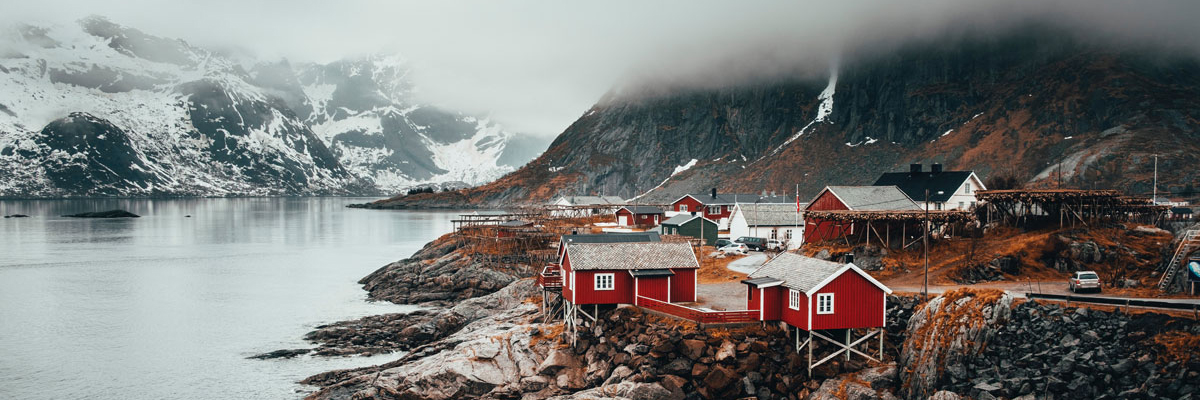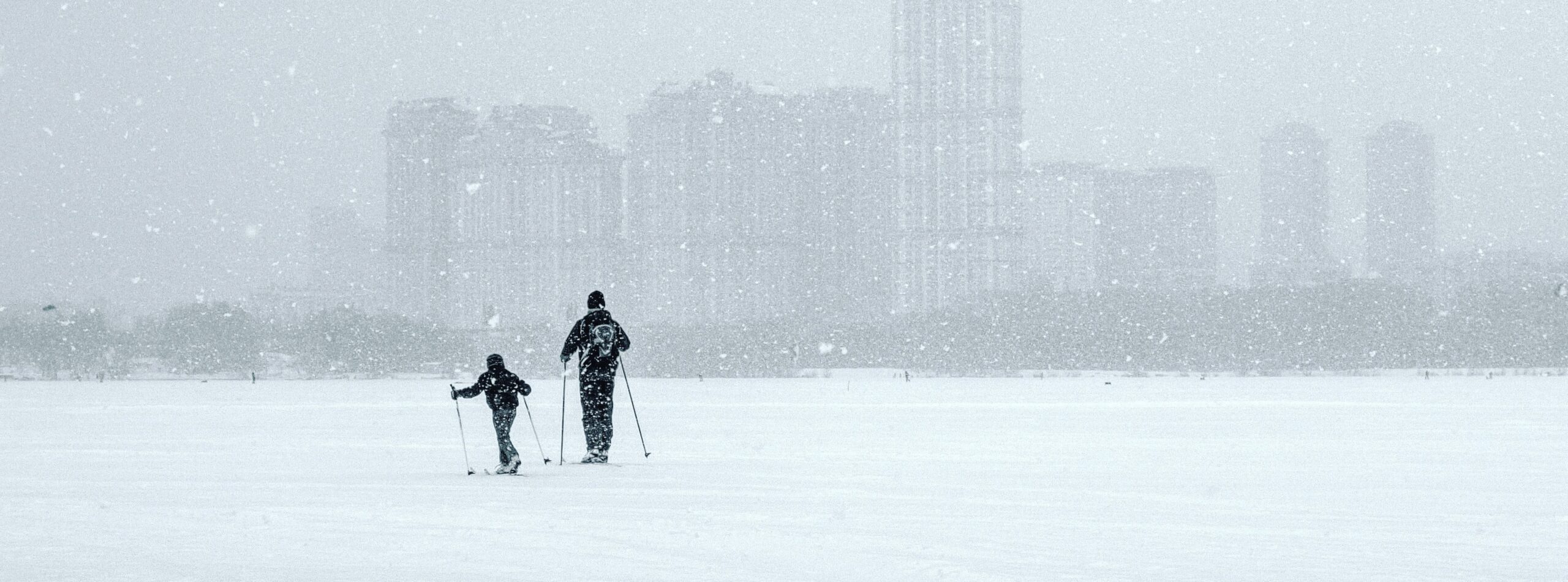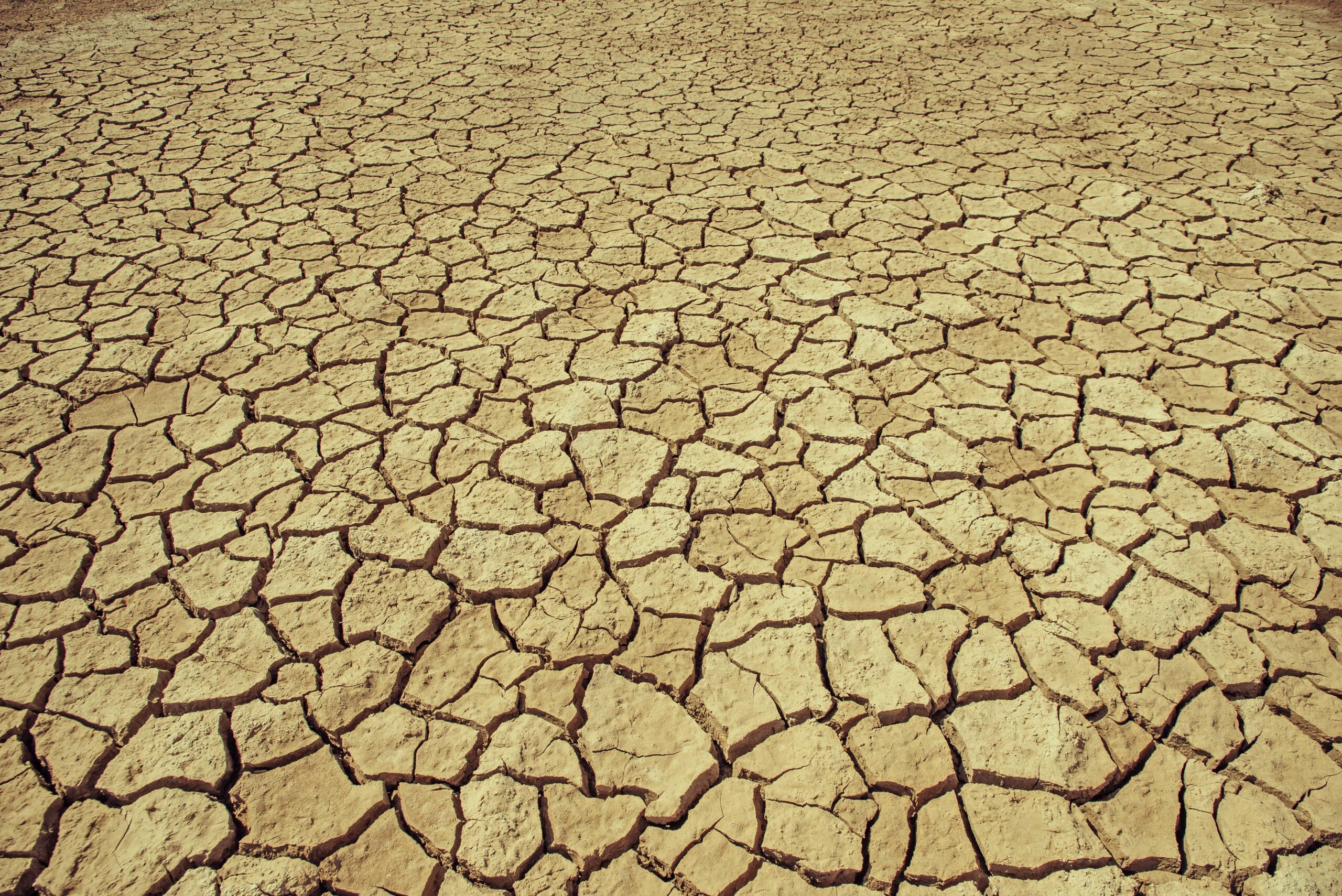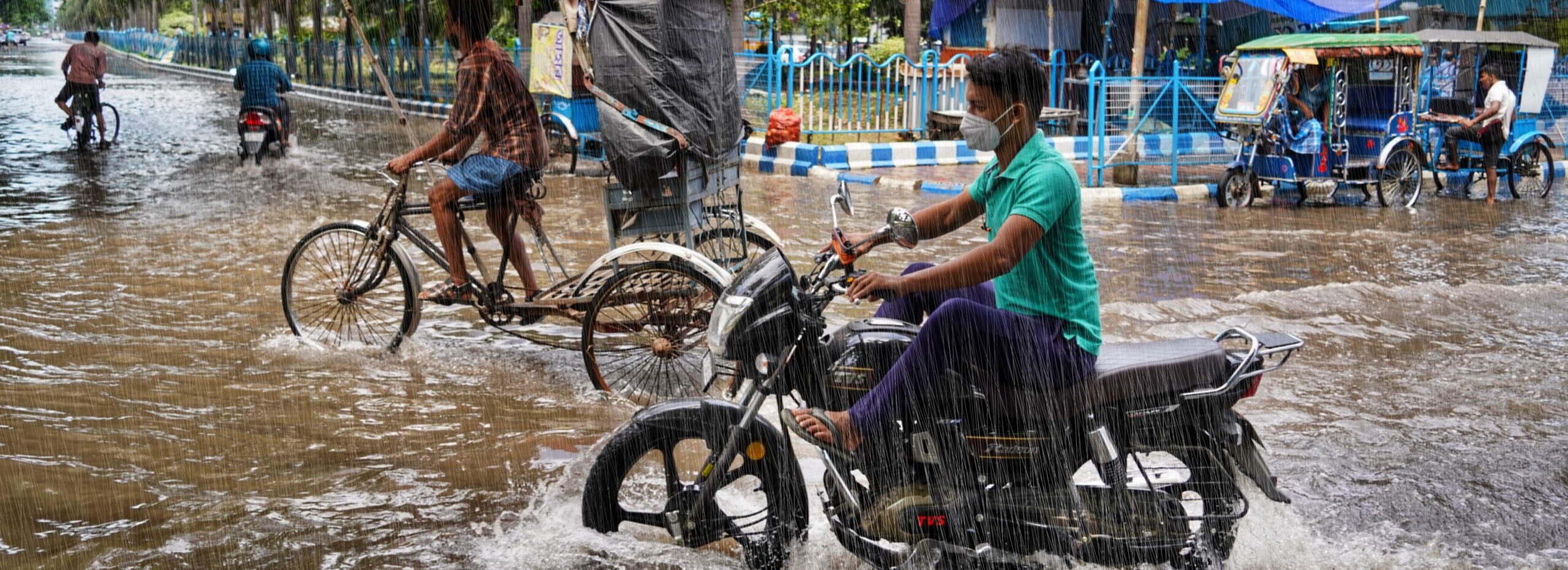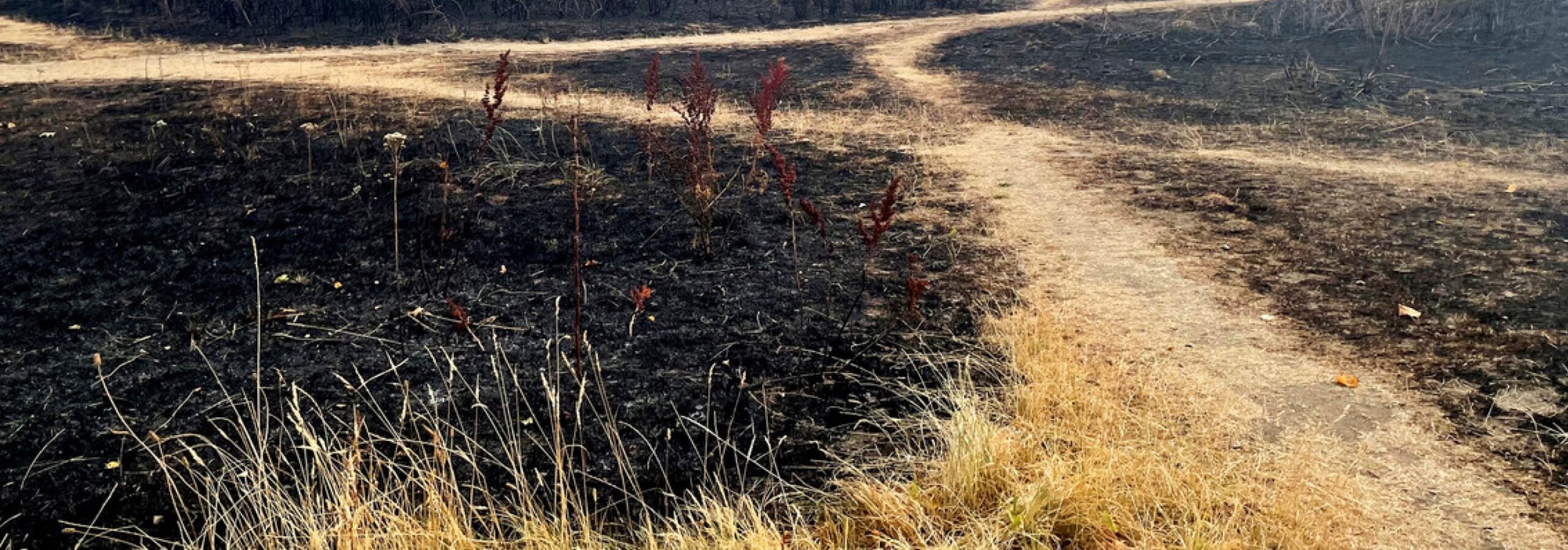The climate of the North Pole in winter is extreme, with 24 hours of darkness and very cold temperatures that vary from year to year and decade to decade.

This year, the North Pole and the surrounding Arctic region are seeing record-high temperatures in November and December (Figure 1a) and record-low ice extent (Figure 1b). Fall usually ushers in the season of sea ice growth, but November saw a brief retreat that was virtually unprecedented in nearly 40 years of satellite records, according to the National Snow and Ice Data Center. That dip helped November set a record low for sea ice area since 1850 (Walsh et al, 2016). By December, the area around the North Pole is typically 95 percent covered by sea ice. However, this year it is only about 80 percent (Figure 1b).
Mid-November saw an early winter “heatwave” with the temperature on November 11 reaching -7 ºC (19 ºF) – that is 15 ºC (27 ºF) above normal for the time of year. The monthly mean November temperature was 13 ºC (23 ºF) above normal on the pole. Temperatures in this region declined slightly after that but remained well above normal. The forecast for the next few days is again more than 15 ºC (27 ºF) above normal at the North Pole itself and 10 ºC (18 ºF) averaged over 80–90 ºC N (Fig. 2).



To quantify how rare the event was, we computed the November-December averaged temperature around the North Pole (80–90 ºN) in the ERA-interim reanalysis augmented with the ECMWF analysis and forecast up to December 25 and persistence up to December 31. The temperatures are slightly less extreme than at the pole itself (Figure 2), but unprecedented in the satellite era from 1979 onwards (Figure 4).
We first note some of the impacts of these high temperatures in the Arctic regions. Next we describe the physical mechanisms that are responsible for sea ice and temperature variability in the North Pole region, which is warming faster than anywhere else in the world. We then analyse the observed temperatures via a related time series encompassing the northern-most meteorological observations on land (70–80 ºN). This allows for a reconstruction of Arctic temperatures back to about 1900, which clearly shows how the current warmth is unprecedented over that period. It also gives a rough estimate of how rare it is in the current climate and how much the probability has changed over the last century.
Finally, we perform a multi-method analysis of North Pole temperatures with two sets of climate models: the CMIP5 multi-model ensemble that was used for the 2013 IPCC AR5 report, and a large ensemble of model runs in the Weather@Home project. Both sets of models give very comparable results, showing that the bulk of the increase is due to anthropogenic emissions. The results are combined in the synthesis and conclusions.
Impacts
Extreme warm events in the Arctic extend into biological and social implications. Unlike the Antarctic, Arctic lands are inhabited and their socio-economic systems are greatly affected by the impacts of extreme and unprecedented sea ice dynamics and temperatures. Recent work by Henri Huntington and colleagues reported on these effects on the timing of marine mammal migrations, their distribution and behaviour and the efficacy of certain hunting methods in the Beaufort Sea. Less than a month ago, Forbes and colleagues reported on the relationship between unseasonal sea ice decline in winter and the enhanced probability of rain-on-snow events in the Yamal Peninsula in north-Western Siberia. While rain on snow does not cause problems in spring, it can be catastrophic for reindeer in the autumn when rain turns to an ice crust as plummeting normal temperatures return. This crust, often several centimetres thick, prevents the reindeer from feeding on fodder beneath the snow throughout the winter months. Two extreme weather events in 2006 and 2013 caused mass starvation among the reindeer herds (one event alone in 2013 resulted in 61,000 reindeer deaths, about 22 percent out of 275,000 reindeer on the Yamal Peninsula), and were linked with sea ice loss in the adjoining Barents and Kara seas. These two examples only illustrate the variety of ways in which climate change in the Arctic directly affects its ecosystems and societies. Many others include effects on the timing of phytoplankton blooms (which are at the base of the food chain in the Arctic ocean) and terrestrial plants, their consequences for animals that depend on these resources, opportunities for invasive southern species to colonise the region, enhanced mobility around the Arctic region for marine mammals such as whales, or reduced and largely modified habitat for animals that directly depend on sea ice such as the polar bear.
Background
The Arctic is the fastest-warming region on Earth, with the largest temperature increases in winter. In summer, the temperature is constrained by all the ice melting and it never rises very far above zero. However, the extra heat absorbed in summer is released in autumn and winter as the water remains warmer for longer and re-freezing sea ice releases the latent energy of melting.
This Arctic amplification of the global warming trend has several causes (see e.g., IPCC WG1 AR5 Box 5.1, Screen & Simmonds, 2010; Bintanja et al, 2011). The best-known is the extra warming due to the change in color (albedo-feedback): when white snow and ice is replaced by dark land and ocean, a much larger fraction of the incoming sunshine is absorbed instead of reflected. This extra heat warms the surface even more. Another positive feedback is less well known and is based on the observation that the warming trend in the Arctic is mainly confined to the lower part of the atmosphere. This is still far below the levels where thermal radiation escapes from the atmosphere on average, which is around 5 km (3 miles) high. This implies that the radiative cooling of the warmer air near the surface is not as efficient as in lower latitudes where the trend at altitude is similar to (mid-latitudes) or higher than (tropics) near the surface. The reduction of radiative cooling due to the vertical structure of the warming trend is called the lapse-rate feedback.
Variability has also increased in the Arctic. On top of the positive feedbacks mentioned above, this is due to two other factors. First, the shape of the Arctic Ocean. Before global warming began in earnest, the basin was filled with ice for most of the year, which implies that except for a few summer months the edge of the ice was relatively short and confined to the Atlantic sector. Now, there are more months in which the ice edge is free of the continents. This allows larger changes from year to year (van der Linden et al, 2014). Another factor is the thickness of the ice. The ice has thinned dramatically, with most of it now single-year ice that is much thinner, and hence flows and melts more quickly (Tschudi et al, 2016). This type of ice changes much more quickly at the whim of the ever-capricious weather, especially combined with the waves and swell that now develop in the ice-free regions (Thomson and Rogers, 2014).
Finally, warm episodes near the pole are usually due to so-called ‘moist intrusions’: warm and moist air from the mid-latitudes that not only advects heat, but also clouds that block outgoing long-wave radiation and hence trap more heat. There is some evidence that these have become more frequent (Woods and Caballero, 2016).
Observations

Satellite observations from about 1979 onwards, coupled with modern weather forecast models, allow a good reconstruction of November–December temperatures on the North Pole over the last 38 years (Fig. 4). There is a clear upward trend since 1990, with November–December 2016 almost 5 ºC (9 ºF) above this trend. However, the trend is not simply up: some cooling occurred in the 1980s. We therefore need longer time series to pin down which part is due to climate change and which to natural variability.
Unfortunately, there are few thermometers near the North Pole, and they tend to drift away as the sea ice flows towards the Atlantic Ocean. The best alternative is to use the thermometers on land around the North Pole. These have been combined into area-averaged temperatures by several teams. We use the GISTEMP (1200 km) data between 70 and 80 ºN, but alternatives (e.g., NOAA/NCDC, Berkeley Earth) give similar results. This series is well correlated to the ERA-interim analysis for 80–90 ºN during the overlap period (r=0.84). The regression, however, is only about 0.6, meaning that the variability and trend of this analysis are lower than at the North Pole itself. The value for December 2016 is estimated from the ECMWF analysis and forecast for the same area, corrected by the local regression over 1979–2015. This gives a November–December temperature of almost 5 ºC (9 ºF) above the 1951–1980 average, far higher than any other values in the series (Fig. 5).

As is well known, this series shows a warm period in the 1930s and 1940s, followed by cooling up through the 1970s and 1980s. The record value of 1944 was not surpassed until 2001 in this series. It turns out that this decadal variability is well described by the Atlantic Multidecadal Oscillation (AMO), nowadays often referred to as Atlantic Multidecadal Variability (AMV) as it does not have a clear period. We use the AMO index of van Oldenborgh et al (2009), which is independent of the warming trend and emphasizes the northern part. Data before 1900 have been discarded. The AMO index was slightly negative in November 2016 with colder than usual sea surface temperatures in the North Atlantic. This decreased the probability of a warm extreme somewhat. We ignore this small effect in 2016 for the rest of the analysis and compute the return period and changes for neutral AMO/AMV, which is a slightly more conservative estimate.

The time series with the regression on the AMO index subtracted is shown in Fig. 6 as a function of the global mean temperature. The temperature increases 2.5±0.6 times faster than the global mean, as discussed in the previous section. The 2016 event is seen to be about two standard deviations above the trend line, which translates to a return period of about 50 years (95 percent CI: 20 to 200, the intersection of the purple and red lines in Fig. 7). Around 1900, when the AMO was also close to neutral, such a temperature would have been so rare that the return period is impossible to estimate (the fit formally gives a few hundred thousand years, but we do not trust such a large extrapolation).

Finally, we add the AMO back into the analysis. The highest value of the AMO index in November-December over the last century was almost 0.6 ºC. This translates to an increase of 0.8 ºC in the 70–80 ºN temperature, so with the highest observed temperatures in the North Atlantic this would now be a 1 in 10 year event (5 to 25), but still less than 1 in 3000 year in the climate of a century ago. Hence, even with a favourable phase of the AMO, 2016 temperatures would have been extremely unlikely at that time. The probability of temperatures reaching the value observed in 2016, including all variability would be between the two extremes of AMO neutral (one in 50 per year) and AMO maximum (one in 10), albeit with large uncertainties. Note that this is the return time of the 70–80 ºN anomaly in November–December 2016. The temperature anomaly in the study region 80–90 ºN is larger (Fig. 1a) and hence the return time in this region will also be larger.
Another limitation of the observational analysis is that the fit assumes that the standard deviation of the Gaussian is constant. There is simply is not enough data to also fit a change in variability. However, we have reason to believe, on physical grounds, that the variability has likely increased. This implies that the true return period of the current event in the current climate is somewhat smaller than the fitted value of 200 year for AMO-neutral conditions, and that the increase in probability is larger than estimated here. Only an analysis using climate models can show how large this effect is.
Coupled climate models
The state-of-the-art climate models from the fifth phase of the Coupled Model Intercomparison Project (CMIP5; Taylor et al. 2012) were used to examine the event with multiple models. This analysis is similar to that described in King et al. (2015).
Table 1. Climate model simulations used in this study. Models shown in bold passed the validation test and were used in the event attribution analysis.
| Model name | Modelling experiment | ||
|---|---|---|---|
| Historical | HistoricalNat | RCP8.5 | |
| ACCESS1.3 | 1,2,3 | 1 | 1 |
| bcc-csm1-1 | 1,2,3 | 1 | 1 |
| CanESM2 | 1,2,3,4,5 | 1,2,3,4,5 | 1,2,3,4,5 |
| CCSM4 | 1,2,3,4,5,6 | 1,2,4,6 | 1,2,4,6 |
| CESM1-CAM5 | 1,2,3 | 1,2,3 | 1,2,3 |
| CNRM-CM5 | 1,2,3,4,5,6,7,8,9,10 | 1,2,4 | 1,2,4 |
| CSIRO-Mk3.6.0 | 1,2,3,4,5,6,7,8,9,10 | 1,2,3,4,5 | 1,2,3,4,5 |
| GFDL-CM3 | 1,2,3,4,5 | 1 | 1 |
| GISS-E2-H | 1,2,3,4,5 | 1 | 1 |
| GISS-E2-R | 1,2,3 | 1 | 1 |
| HadGEM2-ES | 1,2,3,4,5 | 2,3 | 2,3 |
| IPSL-CM5A-LR | 1,2,3,4,5,6 | 1,2,3 | 1,2,3 |
| IPSL-CM5A-MR | 1,2,3 | 1 | 1 |
| MIROC-ESM | 1,2,3 | 1 | 1 |
| MRI-CGCM3 | 1,2,3 | 1 | 1 |
| NorESM1-M | 1,2,3 | 1 | 1 |
Sixteen climate models with at least three historical simulations (natural and anthropogenic forcings) over 1861-2005, one historicalNat simulation (natural forcings only) for 1861-2005, and one RCP8.5 simulation (projected climate under high greenhouse gas emissions) for 2006-2100, were analysed (see Table 1). Two-month (November and December) temperature anomalies were extracted from all model simulations relative to their own historical 1979-2004 baseline periods. The historical simulations were then compared with ERA-Interim over the 1979-2005 period for their trends and year-to-year variability (Fig. 8). Models with at least one-third of historical simulations having trends greater than double the ERA-Interim linear trend were removed from the analysis leaving the 13 used for subsequent analysis (bold in Table 1). Since the variability in ERA-Interim is close to the average across the CMIP5 simulations, it was not used to remove more models for the analysis described below. However, as a sensitivity test, models with more than one-third of simulations failing either the trend test or with average variability of more than 0.5 ºC (0.9 ºF) above or below the ERA-Interim average were also removed. The results were insensitive to this further restriction on the models.

The 13 remaining models (Table 1) were then used to estimate the change in likelihood of events like November-December 2016 or hotter. The likelihoods of such events were estimated in our ensemble of natural runs (for 1901-2005) and the current world runs (2006-2026 in RCP8.5). The temperature anomalies are shown in Fig. 9. Events as hot as 2016 or hotter were not seen in our natural world ensemble. In contrast, events like 2016 or hotter occur in our current world model simulations but are rare, with a return interval of roughly 200 years. These results suggest that it is extremely unlikely this event would occur in the absence of human-induced climate change.

We also investigated when an event like 2016 could become “normal” (e.g., Lewis et al. 2016) in the future. Under the high emissions scenario RCP8.5, we calculated when extreme heat in the Arctic—like 2016—becomes at least a one-in-two year event in 21-year moving windows. We found that by around 2050 (best estimate 2047) heat events like this one would be commonplace, occurring about 50% of the time. This corresponds to a global mean temperature of 2 to 3 ºC (3.6 to 5.4 ºF) above pre-industrial. So even if global warming were limited to 2 ºC (3.6 ºF), such high Arctic temperatures as in 2016 would be warmer than average but not unusual.
Ensemble of SST-forced climate simulations
We also investigated the November-December 2016 Arctic temperatures using ensembles from the weather@home project. These consist of thousands of simulations of the HadAM3P atmospheric model (Massey et. al. 2015), computed by volunteers on their home computers. Three ensembles of simulations were considered. Firstly a climatological set of simulations representing 1986-2013 was used to determine the baseline climate of our model. These used observed sea-surface temperatures and sea-ice from the OSTIA dataset and were one-year simulations from December to November of the following year (climatology). Second was a set of simulations representing November–December 2016 conditions (‘actual’). To produce data for 2016 ahead of time, these used sea-surface temperatures from the UK Met Office seasonal forecast model GloSea5, and 2012 sea-ice from OSTIA, which is closest to 2016 as of November. The third set of simulations also represent 2016, but with human influences removed (‘natural’). This was done by using pre-industrial levels of greenhouse gases and subtracting estimates of anthropogenic SST warming patterns obtained from 11 different CMIP5 models from the GloSea5 sea-surface temperatures (see Haustein et al., 2016). OSTIA sea-ice from the year with greatest sea-ice extent in the dataset (1986) was used in the Arctic. For this analysis we used 3141 2016 ‘actual’ simulations, 6125 2016 ‘natural’ simulations and 8400 climatology simulations (300 per year).
In order to quantify the role of atmospheric circulation in the event, we also analysed subsets of the ensembles which most closely represented the observed atmospheric flow of November 2016 (flow analogues), following the method of Vautard and Yiou (2009). To represent the atmospheric flow we used the 500 hPa geopotential height between 60–90 ºN, and compared with the NCEP-NCAR reanalysis. We selected the 200 closest analogues from each of the ‘actual’ 2016 and ‘natural’ 2016 ensembles, based on the observed November 2016 NCEP-NCAR reanalysis. The distance for these analogues was calculated from the anomalies of the weather@home and NCEP-NCAR reanalysis climatologies respectively. Note that the analogues were chosen on the November 2016 flow and in Fig. 10, the temperature is shown for November-December, for the continuous simulations matching the November analogues.
When analysing the weather@home simulations, we are comparing against anomalies relative to the average over the 1986-2013 climatology period. As the climatology simulations run December to November, we calculate the November and December climatological averages separately rather than from continuous November-December simulations. We note that the weather@home November-December climatological average is -25.53ºC compared to -23.65ºC for ERA-Interim over the same period, which is a 1.88ºC cold bias.
Year-to-year variability of the model is relatively realistic in this region, with the climatological values across years and ensemble members within about 1σ of the ERA-interim variability. However, prescribing SST and sea ice lowers the variance by about 45 percent. In the year 2016, this variance suppression effect appears even more pronounced, 70 percent to 75 percent, due to the larger ice-free area over which SST is prescribed. Future analyses will determine how this influences the atmospheric circulation and maximum temperatures over the region. However, prescribing SST and sea ice and thus artificially reducing variability, means that return periods calculated below are not directly comparable to the return periods obtained in the observational analysis and coupled model framing.
When considering the anomaly for the November-December 2016 event, there is only a single ‘actual’ 2016 simulation as warm as the event, and no ‘natural’ 2016 simulations, see Fig. 10. As there are 3000 ‘actual’ simulations, this indicates that this event is on the order of a 1 in 1000 year event in the present day and extremely unlikely in a climate without human influence with prescribed SST and sea ice.

The mean of the ‘natural’ 2016 ensemble is over 4ºC colder than the ‘actual’ 2016 ensemble, showing a very large change when the anthropogenic signal is removed. This change is still present when considering the 200 simulations that display the closest analogues to the observed flow. The difference in temperature between the ‘actual’ and ‘natural’ analogues is just under 4ºC, so slightly less than the difference of the full ensemble. Hence the temperature trend over years that is characterised by this kind of warm intrusion does not appear to be significantly different from the overall trend in all years, confirming an assumption made in the observational analysis
Conclusions
We have investigated the rarity of the November-December 2016 average temperature around the North Pole and assessed how much November-December average temperatures have changed over the past century using observations over a wider region. We also attempted to quantify how much high Arctic temperatures have changed due to anthropogenic emissions (greenhouse gases and aerosols) in two climate model ensembles.
The observations and the bias-corrected CMIP5 ensemble point to a return period of about 50 to 200 years in the present climate, i.e., the probability of such an extreme is about 0.5 percent to two percent every year, with a large uncertainty. This is rare, but it should be kept in mind that we are focusing on this particular November–December period precisely because an unusual event has occurred. For a random two-month period it would be between six and 12 times more likely. The prescribed SST design of the HadAM3P simulations precludes estimating an absolute return period.
The observations show that November–December temperatures have risen on the North Pole, modulated by decadal North Atlantic variability. For all phases of this variability a warm event like the one of this year would have been extremely unlikely in the climate of a century ago. The probability was so small it is hard to estimate, but less than 0.1 percent per year. The model analyses show that the event would also have been extremely unlikely in a world without anthropogenic emissions of greenhouse gases and aerosols, attributing the cause of the change to human influences. This also holds for the warm extremes caused by the type of circulation of November 2016. If nothing is done to slow climate change, by the time global warming reaches 2 ºC (3.6 ºF) events like this winter would become common at the North Pole, happening every few years.
References
Bintanja, R., Graversen, R.G. and Hazeleger, W. (2011) Arctic winter warming amplified by the thermal inversion and consequent low infrared cooling to space. Nature Geoscience, B: 758–761. doi: 10.1038/NGEO1285
Forbes, B.C., Kumpula, T., Meschtyb, N., Laptander, R., Macias-Fauria, M., Zetterberg, P., Verdonen, M., Skarin, A., Kim, K.-Y., Boisvert, L.N., Stroeve, J.C. and Bartsch, A. (2016) Sea ice, rain-on-snow and tundra reindeer nomadism in Arctic Russia. Biology Letters, 12(11): 20160466. doi: 10.1098/rsbl.2016.0466
Haustein, K., Otto, F.E.L., Uhe, P., Schaller, N., Allen, M.R., Hermanson, L., Christidis, N., McLean, P. and Cullen, H. (2016) Real-time extreme weather event attribution with forecast seasonal SSTs. Environmental Research Letters, 11(6): doi: 10.1088/1748–9326/11/6/064 006
Huntington, H.P., Quakenbush, L.T. and Nelson, M. (2016) Effects of changing sea ice on marine mammals and subsistence hunters in northern Alaska from traditional knowledge interviews. Biology Letters, 12: 20160466. doi: 10.1098/rsbl.2016.0198
King, A. D., van Oldenborgh, G.J., Karoly, D.J., Lewis, S.C. and Cullen, H. (2015) Attribution of the record high central England temperature of 2014 to anthropogenic influences. Environmental Research Letters, 10(5): 054002. doi: 10.1088/1748-9326/10/5/054002
Lewis, S.C., King, A.D. and Perkins-Kirkpatrick, S.E. (2016) Defining a new normal for temperature extremes in a warming world. Bulletin of the American Meteorological Society, 98(6): 1139–1151. doi: 10.1175/BAMS-D-16-0183.1
Massey, N., Jones, R., Otto, F.E.L., Aina, T., Wilson, S., Murphy, J.M., Hassell, D., Yamazaki, Y.H. and Allen, M.R. (2015) weather@home— development and validation of a very large ensemble modelling system for probabilistic event attribution. Quarterly Journal of the Royal Meteorological Society, 141: 1528–1545. doi: 10.1002/qj.2455
Screen, J.A. and Simmonds, I. (2010) The central role of diminishing sea ice in recent Arctic temperature amplification. Nature, 464(7293): 1334-1337, doi: 10.1038/nature09051
Taylor, K.E., Stouffer, R.J. and Meehl, G.A. (2012) An overview of CMIP5 and the experiment 962 design. Bulletin of the American Meteorological Society, 93: 485–498. doi: 10.1175/BAMS-D-11-00094.1
Thomson, J. and Rogers, W.E. (2014) Swell and sea in the emerging Arctic Ocean. Geophysical Research Letters, 41: 3136–3140, doi: 10.1002/2014GL059983.
Tschudi, M., Fowler. C., Maslanik., J., Stewart, J.S. and Meier, M. (2016) EASE-Grid Sea Ice Age, Version 3. NASA National Snow and Ice Data Center Distributed Active Archive Center. doi: 10.5067/PFSVFZA9Y85G.
Vautard, R. and Yiou, P. (2009) Control of recent European surface climate change by atmospheric flow. Geophysical Research Letters, 36: L22702. doi: 10.1029/2009GL040480
van der Linden, E., Bintanja, R., Hazeleger, W. and Katsman, C. (2014) The role of the mean state of Arctic sea ice on near-surface temperature trends. J. Climate, 27: 2819–2841. doi: 10.1175/JCLI-D-12-00617.1.
van Oldenborgh, G.J., te Raa, L.A., Dijkstra, H.A. and Philip, S.Y. (2009) Frequency- or amplitude-dependent effects of the atlantic meridional overturning on the tropical Pacific Ocean. Ocean Science, 5(3): 293–301. doi: 10.5194/os-5-293-2009
Walsh, J.E., Fetterer, F., Scott Stewart, J. and Chapman, W. L. (2016) A database for depicting Arctic sea ice variations back to 1850. Geographical Review, 107(1): 89–107. doi: 10.1111/j.1931-0846.2016.12195.x
Woods, C. and Caballero, R. (2016) The role of moist intrusions in winter Arctic warming and sea ice decline. Journal of Climate, 29 (12): 4473–4485, doi: 10.1175/jcli-d-15-0773.1

